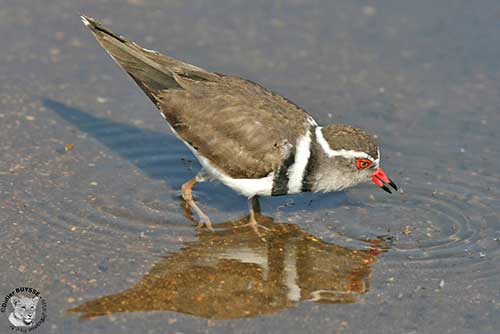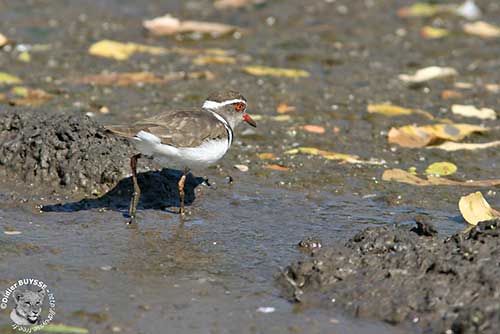
Fr: Gravelot à triple collier
Ang: Three-banded Plover
All: Dreiband-Regenpfeifer
Esp: Chorlitejo Tricollar
Ita: Corriere dai tre collari
Nd: Driebandplevier
Sd: trebandad pipare
Photographer:
Didier Buysse
Vision d’Oiseaux
Text by Nicole Bouglouan
Sources:
HANDBOOK OF THE BIRDS OF THE WORLD Vol 3 by Josep del Hoyo-Andrew Elliott-Jordi Sargatal - Lynx Edicions - ISBN : 8487334202
SHOREBIRDS by Peter Hayman, John Marchant and Tony Prater – Christopher Helm – 1986 – ISBN: 0747014035
GUIDE DES LIMICOLES de D. Taylor - Delachaux et Niestlé - ISBN : 2603014080
Biodiversity Explorer – The Web of Life in Southern Africa
Wikipedia, the free encyclopaedia
The Guardian - Mystery bird: three-banded plover, Charadrius tricollaris
The Kruger National Park - Kruger Birding Articles
Wildlife Vagabond - Three-Banded Plover
Three-banded Plover
Charadrius tricollaris
Charadriiformes Order – Charadriidae Family
INTRODUCTION:
The Three-banded Plover is included in the subfamily Charadriinae in the order Charadriiformes. This plover is typical of inland waters where it feeds on various aquatic invertebrates. This fairly small, dark plover is about the size of a House Sparrow. Its peculiar plumage and head pattern make it easy to identify.
This sub-Saharan wader is mainly sedentary in its range with some post-breeding movements.

DESCRIPTION OF THE BIRDS:
Biometrics:
Length: 18 cm
Weight: 35 g (28-49 g)
The adult has dark brown head and upperparts. The upperwing shows a short, white trailing edge and a narrow white wingbar, both visible in flight. The tail has unbarred white sides and tip.
On the underparts, we can see the three bands that give the bird its name: two conspicuous black breast bands separated by a white third one, and contrasting with the white rest of the underparts. Underwing and axillaries are white, with brown tinge on outer coverts and narrow leading edge. The undertail-coverts are white.
On the head, the forehead is white. Crown and nape are dark brown, surrounded by a white stripe forming a complete circle. Lores, cheeks, neck sides and hindneck are pale brown, becoming mostly whitish on chin, throat and foreneck.
The bill is bright pinkish-red with black tip. The eyes are pale walnut-brown to golden, surrounded by a conspicuous red-orange eyering. Legs and feet are pale pinkish-brown.
Male and female are similar.
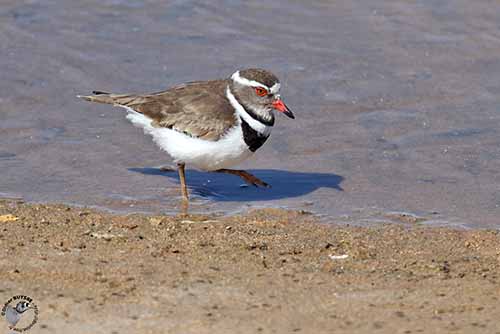
The juvenile has dark brown upperparts with narrow pale buff fringes to feathers, involving scaled effect. The breast bands appear before fledging, but first, the brown upper band is incomplete and the lower one has some black feathers. On the head, the forehead is pale brown and the red eyering is duller and more indistinct.
The Three-banded Plover is very similar to the Forbes's Plover or Forbes's banded Plover (Charadrius forbesi), but the latter has dark forehead, grey throat, broader and duller breast bands and barred black-and-white outer rectrices.
SUBSPECIES AND RANGE:
The Three-banded Plover has two subspecies.
C.t. tricollaris (described and displayed) occurs in Egypt (a recently colonized country by this bird), in Eritrea to Tanzania, S to DR Congo and Gabon, and S to South Africa. The non-breeding birds can be seen around Lake Chad.
C.t. bifrontatus occurs in Madagascar. This race has darker face and throat, and grey band between the bill and the white forehead.
HABITAT:
The Three-banded Plover frequents the wetland fringes and usually occurs on gravelly or muddy grounds around inland freshwaters such as lakes, pools and rivers. It is more rarely seen at estuaries and coastal lagoons or even beaches and brackish inland waters.
It roosts and nests on shingle or stony ground higher up shore.
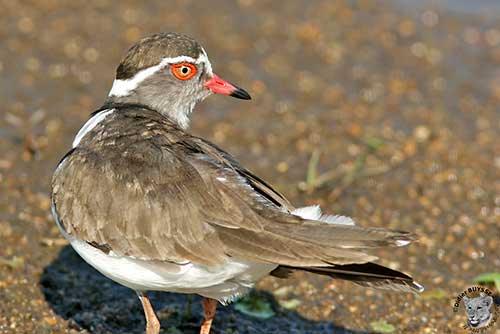
CALLS AND SONGS: SOUNDS BY XENO-CANTO
The Three-banded Plover gives high-pitched, penetrating whistles with rising inflection “weee-weet” and fast, longer series when excited “wit-wit-wit-weet-weet” also given when flushed. We can also hear a shrill “wick-wick”.
The sing given during displays is a longer, repeated “peeee” often associated with short trills “peee…peee…trrr…trrr…trrr”
BEHAVIOUR IN THE WILD:
The Three-banded Plover feeds on aquatic invertebrates such as insects and their larvae, small crustaceans, molluscs and worms. However, it also feeds on terrestrial invertebrates.
It forages mainly on open shores and uses the typical “running-stopping-searching for prey” technique. It picks up food items from the water surface or just below, about 10-40 times per minute. It also uses “foot-trembling” to disturb the preys.
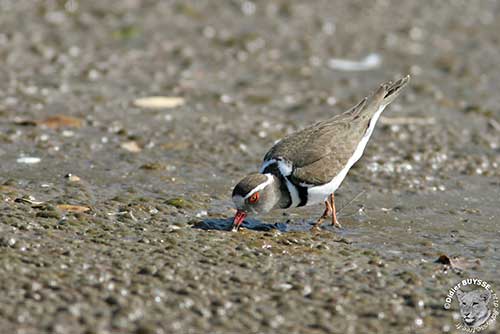
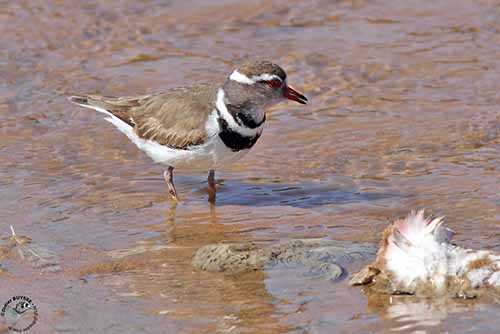
It is often seen alone, although is mixes with other small waders. Flocks of up to 40 birds are occasionally formed. It may feed throughout day or night.
Like most plovers, the Three-banded Plover has socially monogamous mating system. It is territorial and defends the territory aggressively by running or flying at intruders, another plover or a different species. Another defence display shows the bird bobbing its head up and down while giving a high-pitched whistle. This species is solitary nester.
The Three-banded Plover is mainly sedentary in its range, but it performs some erratic, poorly known, movements. In South Africa, these movements probably depend on rains. Longer movements may occur sometimes, and the birds may wander to higher elevations in some parts of the range, up to 2350 metres in Malawi.
The Three-banded Plover has long wings and tail, both conspicuous in flight, giving the bird an elongated appearance. These morphological features are not the most manoeuvrable, but the flight is rapid and easy.
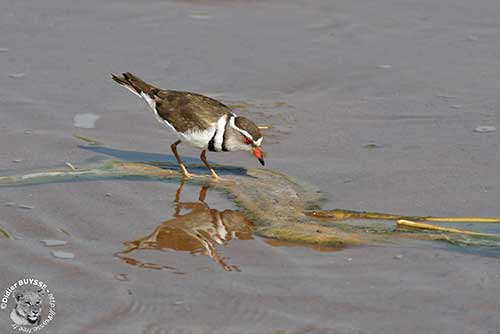
REPRODUCTION OF THIS SPECIES:
The breeding season varies depending on the range. The egg-laying season occurs almost year-round, with peak between July and December.
The Three-banded Plover nests in sand, shingle or dry mud. The nest is a shallow scrape, usually lined with dried materials, pieces of plants, pebbles and debris. It is placed close to the water.
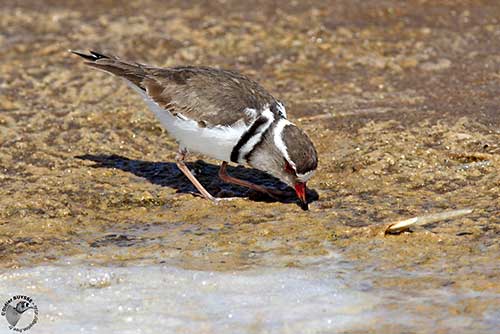
The female lays 1-2 whitish eggs with black markings, making them invisible among stones and pebbles. Both adults share the incubation during 26-28 days, the female by day while the male defends the area, and the male by night while the female is feeding.
At hatching, the downy chicks have sandy, speckled black upperparts and a black median stripe, whereas the underparts are white. They are brooded during the first days and fed by both parents. They are able to fly about three weeks after hatching, and more strongly 10 days later. They remain sometimes 40-42 days with their parents. This species often produces two clutches per year.

PROTECTION / THREATS / STATUS:
The Three-banded Plover is fairly tolerant of disturbance, and the constructions of artificial water bodies involve new suitable habitats for this species.
The population is estimated at 70,000/140,000 mature individuals (Wetland International 2014).
The Three-banded Plover is currently evaluated as Least Concern.
